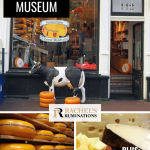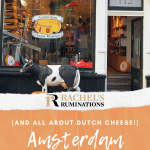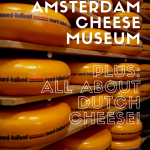Amsterdam Cheese Museum review + all about Dutch cheese!
Amsterdam Cheese Museum isn’t really a museum: it’s a shop. It’s a very nice shop, mind you, where you get to taste lots of different Dutch cheeses before making a purchase. A bonus is that everything is labeled in English.
The museum part, however, is pretty minimal, but at least it’s free.
Disclosure: This article contains affiliate links. If you click on one and make a purchase, I will receive a small commission. This will not affect your price.

Getting to the Cheese Museum
The Amsterdam Cheese Museum looks like a regular storefront and when you step inside, it looks like a shop, with lots of cheese and other items like chocolate.
To get to the museum part, squirm your way through the cheese-tasting crowds to the very back of the store, where you’ll find the stairway down into the basement. The museum consists of a single basement room, holding a small exhibition about Dutch cheese.
It’s not a big room and the displays are along the sides and down the center. Here, you can learn all you ever wanted to know about Dutch cheese-making, present and past, with photos and explanations and old tools.

Signs explain all of the steps in the process of cheese production: what kinds of cows the milk comes from; how rennet is added to warmed-up milk; how the curds are separated from the whey, then pressed in molds to dry and thicken; and how it’s dipped in salt water, then aged on wooden shelves.
For children, there are costumes to try on, which I’m sure would make some cute photos.
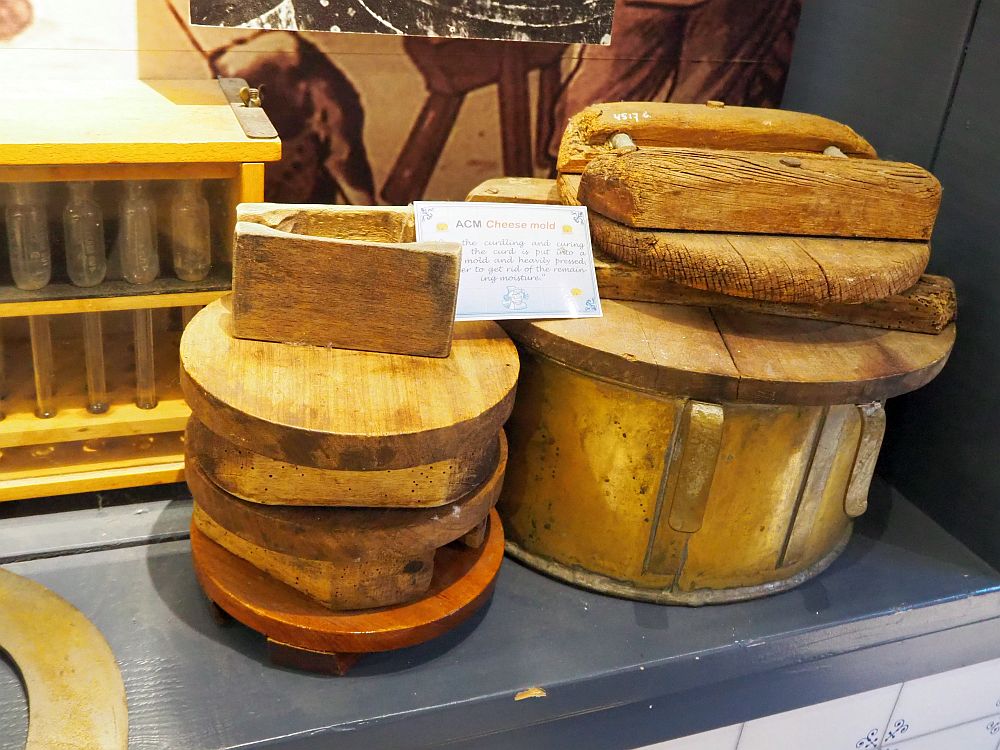
It’ll take you about 10-15 minutes to see the whole thing. When you’ve finished, head back upstairs and do some tasting next.
I’ll get to my Amsterdam Cheese Museum review toward the end of this article, but first, let’s talk Dutch cheese.
While you’re here, check out my series on small museums and other sights to see in Amsterdam!
About Dutch cheese
I’ve learned all the basics about Dutch cheese in the 20+ years I’ve lived here. After all, the Dutch take their cheese very seriously. In fact, the most popular type, called “Gouda” because it was originally produced in the town of Gouda, is often just called kaas here, which translates as “cheese.”
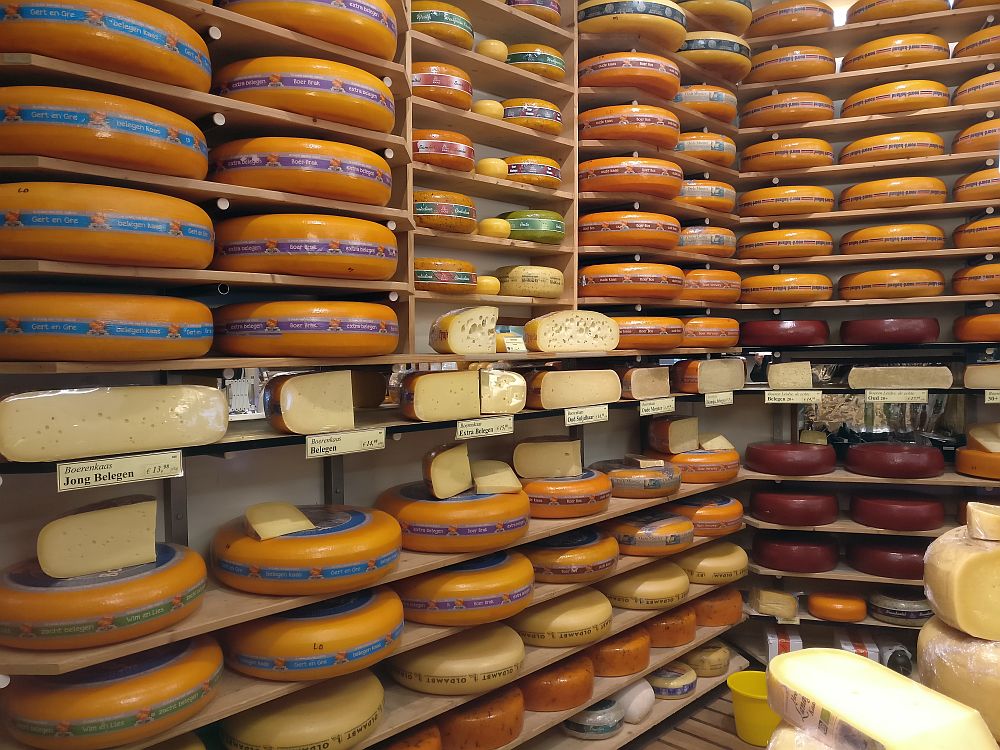
Edam (also named after a town) is similar to Gouda in flavor, but while Gouda is produced in huge, flat wheels of cheese, Edam is sold in much smaller ball-shaped wheels. Locals don’t buy whole wheels of either one; they buy a wedge, which, in a proper cheese shop, the seller will cut to the size you want.
Various brands of cheese will taste slightly different from each other. The most famous, Old Amsterdam (which sells young cheese as well as old, to confuse matters), has a slightly more intense flavor than some others. Boerenkaas, which means farmers cheese, often has a creamier flavor, and is made from unpasteurized milk. It’s not a brand but more of a sub-type of gouda.
Graskaas is cheese made from the first few milkings after the cows are released into the fields in the springtime. It’s supposed to be creamier and milder because of the young grass the cows eat, but I admit I’ve never tasted it.
Types of Dutch cheese
Dutch cheese comes in a much bigger array of types and flavors than you’d think if you’ve only bought it as a treat in some other country.

The first variable is its age. The older the cheese is – in other words, how long it’s ripened – the sharper the flavor. The youngest cheese is called jong, meaning “young,” and it’s so mild it tastes pretty similar to butter, with a smooth texture. It’s only ripened for about a month. Old cheese is called oud; it has a much sharper flavor and crumbles easily. The cheese that’s halfway between is called belegen. There are more gradations as well, so the whole spectrum from youngest to oldest is this:
- Jong
- Jong belegen
- Belegen
- Oud belegen
- Oud
- Zeer oud or extra oud or overjarig
The zeer oud (very old) cheese is really sharp and very dry and crumbly, ripened for about a year. It can work nicely as a replacement for parmesan in cooking, but of course it’s the most expensive because of the long ripening period.
If the cheese says 48+, it was made with full-fat milk. 30+ is lighter, but it’s less creamy. 20+ is the serious dieter’s cheese, but the flavor just isn’t worth it, in my view.
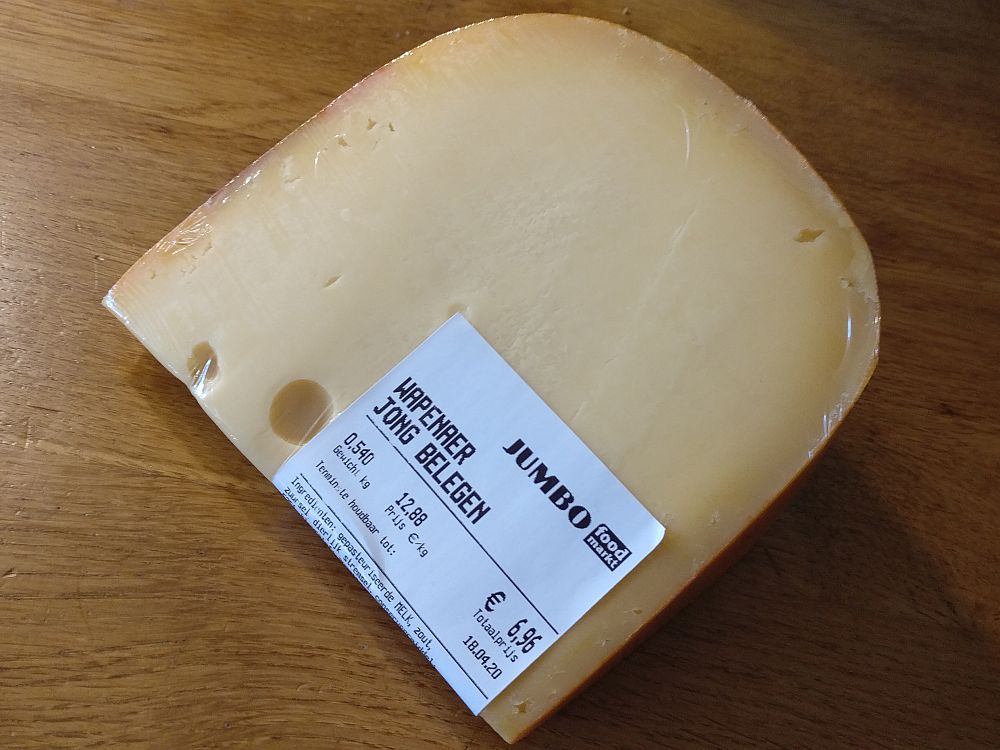
Other flavors of cheese
Besides the standard age designations, other flavorings are often added to the cheese during production. The more traditional ones are netelkaas, with nettles, mosterdkaas (mustard cheese) with mustard seeds, nagelkaas (clove cheese), and komijnkaas (cumin cheese). These, in turn, can come in a range of ages.
Another option is smoked cheese (rookkaas), which is absolutely scrumptious on a cheeseburger!
Nowadays, though, the choices have expanded enormously: this shop that calls itself a museum has, for example, hot chili cheese, garlic cheese, truffle cheese, and several varieties of pesto cheese!

Goat and sheep milk cheeses are becoming increasingly popular as well. I’m not sure if this stems from environmental concerns – the Netherlands has a lot of cows, which have a bigger carbon footprint than other livestock – or if it’s based on flavor. These cheeses, if they’re from the Netherlands, are made in the same way as gouda, so the wheel won’t look much different. When you slice into it, though, the cheese will look whiter than cow’s milk Gouda, and the flavor is quite different, though the texture will be similar.
Goat and sheep milk cheeses have an earthier, stronger flavor, even when they’re jong or jong belegen.
You might also enjoy these articles:
- Eating Europe’s Jordaan Food Tour: A review (learning all about Dutch specialties in the Jordaan neighborhood in Amsterdam)
- Yotel Hotel at Schiphol: A review
- Things to do at Schiphol Airport (while you wait for your flight)
- Amsterdam Central train station sightseeing (things to see right near the station when you don’t have much time)
- Exploring Amsterdam’s undiscovered north (This will take more time and get you away from the worst of Amsterdam’s tourist crowds.)
How to eat Dutch cheese
I’ve really only seen Dutch people eat cheese in one of three ways.
Most commonly, they slice the cheese very thinly using a cheese slicer. (Please, if you did not grow up using a cheese slicer, use it very carefully!) Then, they make a sandwich with it: a thin layer of butter or margarine, then a single layer of cheese, usually on brown bread. For lunch, they’ll have one of these – to an American eye it’s only half a sandwich – and several other sandwiches with, for example, a single layer of ham or some peanut butter (thinly spread, and always with butter or margarine, never with jam) or hagel slag (chocolate sprinkles) or whatever else.
Dutch people often eat cheese on social occasions or in pubs, where the cheese is cut into bite-sized chunks and served as a nibble.
Don’t forget to book your accommodations for your trip to Amsterdam! Use the map below:
Third, Dutch cheese is quite useful for cooking: the younger varieties melt nicely, more like Monterey Jack than cheddar. If you’re going to use it for cooking, don’t go riper than belegen. The older cheeses are stronger tasting but don’t melt readily like the younger cheeses do.
If Dutch food culture interests you, read this overview of eating in the Netherlands, which I can say, from my 25 years in the Netherlands, is completely correct, except that I would argue that good erwtensoep (thick pea soup) is definitely worth eating, especially on a cold winter’s day!
Amsterdam Cheese Museum review: is it worth visiting?
If you happen to be in the neighborhood, go ahead and stop in. It’s free, and even if you have no interest in learning about cheese-making, you can taste lots of cheeses. I’d suggest first tasting plain cheese in order of age: young to old. After that, taste whatever else strikes your fancy.
The Tulip Museum is another one that’s part shop and part museum, but the museum part is a bit more substantial. Read my review of the Tulip Museum.
Any proper cheese shop (in other words, not a supermarket) will also let you taste cheeses, and most likely without the crowds. They’ll often have bits of cheese in little cups for you to help yourself. Even if they don’t, it’s perfectly acceptable to ask for some tastes to help you decide what to buy. They’ll use a cheese slicer to shave off a bit for you.
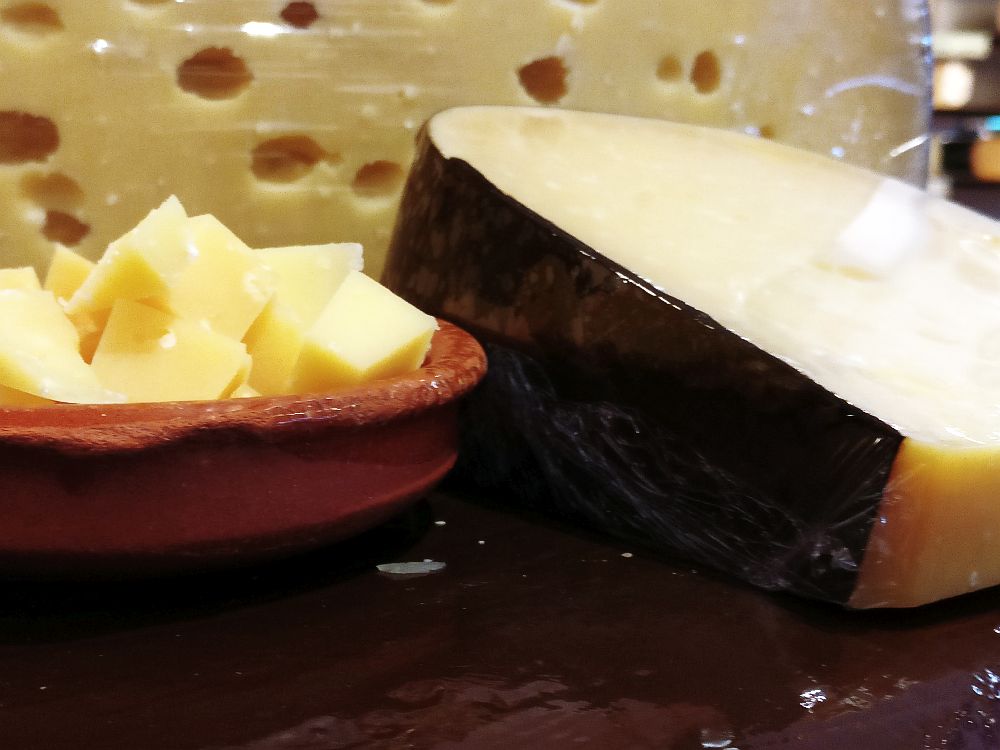
Buying cheese to take home
If you’re going to buy cheese to take home, ask that your wedge be vacuum-packed; most cheese shops have the machine to do so. It’ll last several weeks outside of a fridge that way. Your other choice is to buy a whole wheel, which is really only practical if you buy Edam rather than Gouda, or some of the mini-rounds they produce for tourists. A wheel can last for months if you don’t cut it open. After that, or after opening your vacuum-pack of gouda, it’s best to keep it in the fridge.
While you’re planning your trip to Amsterdam, think about whether to buy a GoCity card. If you plan to see a lot of the sights, it could save you quite a bit of money.
Dutch cheeses are generally priced by the kilo, though sometimes they’re priced per 100 grams. In supermarkets, they’re usually cut into wedges with the price already marked. In a cheese shop, the person behind the counter will ask you to indicate how much you want them to cut off the wheel for you. They’ll weigh it and get your okay before wrapping it up.
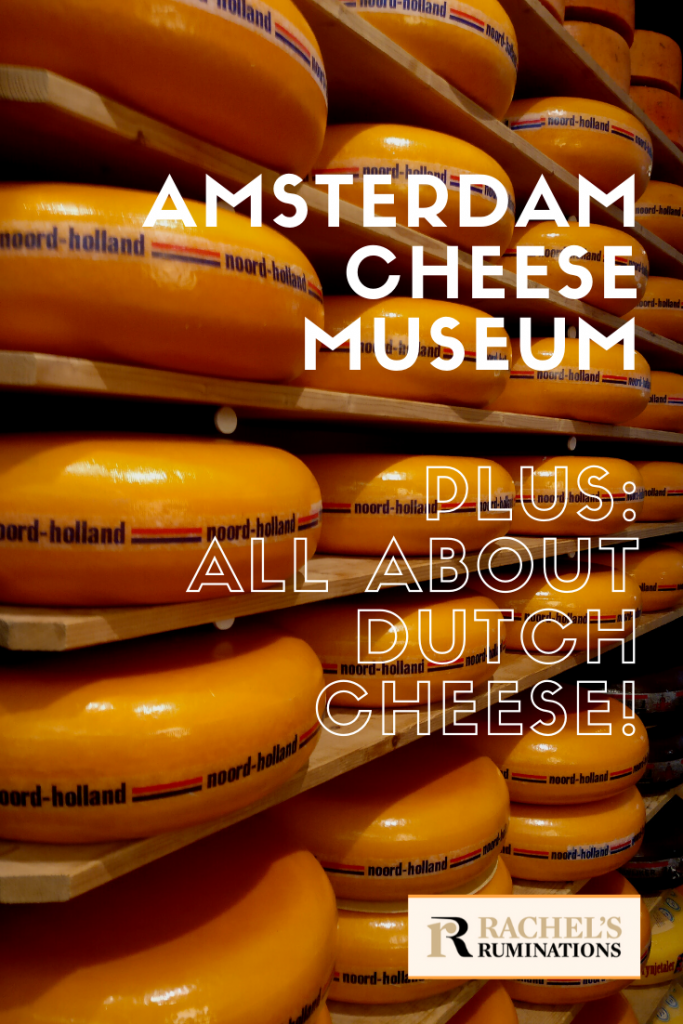
A security threat?
Apparently Dutch gouda has the exact same density as plastic explosives. Security has stopped me at Schiphol airport a number of times to have my bag opened and examined. It’s not a problem, but be aware that it might slow you down at security. When you pack your carry-on bag, make sure any wires from any electronics are far from the cheese. It’s the combination of plastic explosives and wiring that security personnel watch for. I assume that if you pack cheese in your checked bags, they’re likely to get opened, which is why I usually carry it on.
Amsterdam Cheese Museum: Prinsengracht 112. From Central Station, take tram 13 or 17 to the Westermarkt stop. Open daily 9:00-19:00. Admission: free.
If I’ve forgotten any information here that you’d like to know about Dutch cheeses, please add your question below and I’ll answer it for you. Please also share this article on your favorite social media!
My travel recommendations
Planning travel
- Skyscanner is where I always start my flight searches.
- Booking.com is the company I use most for finding accommodations. If you prefer, Expedia offers more or less the same.
- Discover Cars offers an easy way to compare prices from all of the major car-rental companies in one place.
- Use Viator or GetYourGuide to find walking tours, day tours, airport pickups, city cards, tickets and whatever else you need at your destination.
- Bookmundi is great when you’re looking for a longer tour of a few days to a few weeks, private or with a group, pretty much anywhere in the world. Lots of different tour companies list their tours here, so you can comparison shop.
- GetTransfer is the place to book your airport-to-hotel transfers (and vice-versa). It’s so reassuring to have this all set up and paid for ahead of time, rather than having to make decisions after a long, tiring flight!
- Buy a GoCity Pass when you’re planning to do a lot of sightseeing on a city trip. It can save you a lot on admissions to museums and other attractions in big cities like New York and Amsterdam.
- Ferryhopper is a convenient way to book ferries ahead of time. They cover ferry bookings in 33 different countries at last count.
Other travel-related items
- It’s really awkward to have to rely on WIFI when you travel overseas. I’ve tried several e-sim cards, and GigSky’s e-sim was the one that was easiest to activate and use. You buy it through their app and activate it when you need it. Use the code RACHEL10 to get a 10% discount!
- Another option I just recently tried for the first time is a portable wifi modem by WifiCandy. It supports up to 8 devices and you just carry it along in your pocket or bag! If you’re traveling with a family or group, it might end up cheaper to use than an e-sim. Use the code RACHELSRUMINATIONS for a 10% discount.
- I’m a fan of SCOTTeVEST’s jackets and vests because when I wear one, I don’t have to carry a handbag. I feel like all my stuff is safer when I travel because it’s in inside pockets close to my body.
- I use ExpressVPN on my phone and laptop when I travel. It keeps me safe from hackers when I use public or hotel wifi.


